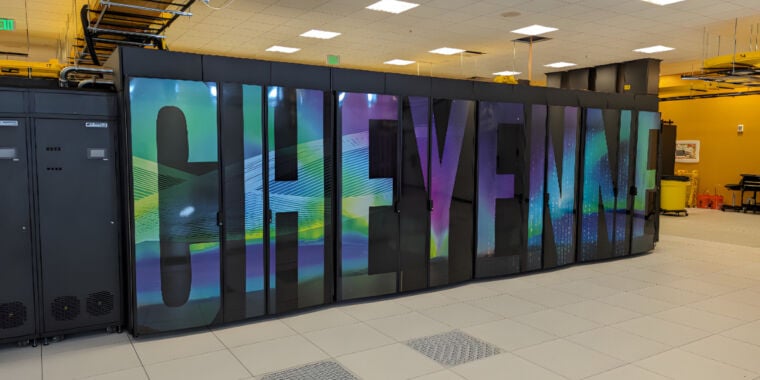Winner looking at his electricity bill:

Hey, I have worked on this exact machine before, neat to see they are finally decommissioning it. It would be a terrible purchase to actually use these days though, for the cost of moving and deploying it you could rock a few Hopper or Grace clusters that would outperform the cluster for less than half of the operating overhead.
I fully expect it to get parted out, the actual components would be far more useful on their own as cheap homelab systems, and would be a much better ROI versus using it as is. This thing is water cooled, just the plumbing would be a nightmare to deal with if you aren’t set up for it, and if you are you would be better off going with a modern architecture anyway.
What were you using it for?
We were running meteorological models mostly, but I did have a colleague that was trying to use it to predict wildlife migratory patterns using topographical mapping. It was batched out on a few projects at any given time while I was there, it was essentially timeshares between a few different research departments.
Do you mean to tell me you didn’t run Doom on that?!
Haha, unfortunately no. None of the blades used a windowing system, so we technically wouldn’t have been able to as there is no graphical output (well, the IPMI controllers could have, but that’s kind of cheating). Although, as I’m thinking about it… We probably could have run it over ASCII graphics in a terminal… Man, that was a bit of a wasted opportunity, weather modelling is boring as hell.
Power consumption: 1.7 MW
I hope it stays decommissioned. We’re burning up the planet too fast already, and old computers tend to be far less efficient than modern ones.
Pop up a solar farm and you are good to go, baby!
Yeah just need 10Mw+ of solar and like 40mwh of batteries to power it 24/7
So just the 10 million dollar solar farm? easy peasy
Plus the batteries, unless you only want to run the thing while the sun is up
Yeah, I saw the 4Mil BTU on another page, that’s a lot of heat output
Damn that’s crazy. When I was just out of college I built the touchscreen web app that promoted this thing in the lobby of UCAR. Looks like it’s still running for now: https://hpctv.ucar.edu
That is a really cool resume item, ngl
Do you mind me asking the languages/frameworks backing it? (e.g. JavaScript/Node)
Thanks! It was a Python backend that the data science team at UCAR built and a Vue.js front end.
Neat application. Looks fun :D
The specs seem to be just enough to run a Minecraft server that doesn’t freeze when one player explores new chunks.
no use, minecraft server is single threaded. it won’t hit 20TPS in an even slightly complex world no matter how much compute you throw at it
Yeah but you can put the whole world on RAM disk.
The price will only be exceeded by the power bill for the electricity needed to run it.
This thing is basically the size of my apartment.
Which means I have room! How much?
Currently around $51k, reserve not yet met. Buyer responsible for transportation and cabling not included, fyi.
Iirc bid yest was 15k reserve not met tho
Who wants to go in with me on this?
New Lemmy server?
Let’s turn it into a Lemmy server.
Killing a fly with canon there, aren’t you?
I call it future proofing.
Some people don’t understand exponential growth. We expect Lemmy to have 50 billion users by 2026 and we need to be ready for it.
Building a cannon to shoot for the moon
I hope Matthew Broderick buys it.
And then programs it to play a nice game of chess
No, let’s play Global Thermonuclear War
*Global Thermonuclear War
Ah yup, thank you
It’s kind of lame that they need to junk the entire apparatus after only a decade. I get that processor technology moves on apace but we already know it does that so why doesn’t a universal architecture exist where nodes can be added at will?
It’s more of an operating cost issue. It’s almost decade-old hardware. It was efficient in its day, but compared to new hardware it just costs so much to run you would be better served investing in something with modern efficiency. It won’t be junked, it will be parted out. If you are someone that wants a cheap homelab with infiniband and shitloads of memory you could pick up a blade for a fraction of what it would otherwise cost. I fully expect it to turn into thousands of reasonably powerful servers for the prosumer and nerd markets instead of running as a monolithic cluster.
A decade is a lifetime in technology. Moore’s law had just ended when this was put together.
One of the reasons why I work in industrial controls. A good day is me sneaking in tech that came after the year 2000. Employment for life and I get to branch out to related stuff. Employer is paying me to take ME and chem-e classes now.
I don’t know why anyone would spend their life chasing the newest fad tech when you can pick a slow moving one, master it, and master the ones around it. Would much rather be the person who knew how the entire system works vs knowing the last 8 programming languages/frameworks only 1 of which is relevant.
But hey glad there are people who decide on that lifestyle I like having a better cellphone every year.
If you have too many “slow” modes in a super computer you’ll hit a performance ceiling where everything is bottle necked by the speed of things that are not the CPU: memory, disk for swap, and network for sending partial results across nodes for further partial computing.
Source: I’ve hang up too much around people doing PhD thesis in these kinds of problems.
I would imagine it’s very difficult to make a universal architecture but if I have learnt anything about computers it’s that the manufacturers of software and hardware deliberately created opaque and monolithic systems, e.g. phones. They cynically insert barriers to their reuse and redeployment. There’s no profit motive for corporations to make infintitely scalable computers. Short sighted greed is a much more plausible explanation.
When you get to write and benchmark your own code you’ll see technology has limits and how they impact you.
You can have as many raspberry pis as you want, and accomplish faster computation if you can use the same budget with Xeon on dozens of MB in cache and hundreds of gb in ram with gigabit network cards.
10 years from now these Xeon will be like rpi compared to the best your money can buy.
All of those things have to fit in a building, not a desk. The best super computers look like Google’s data centers, but their specific needs dictate several tweaks done by very smart people. Super computers are supposed to solve 1 problem with 1 set of data at a time, not 100 problems with 1000,000 data set/people profiles at a time which are much easier to partition and assign to only 1000th of your data center at a time.
Seems like it’s cheap to start the bidding at $2500 but the cheapest thing is probably the initial purchase price after moving it, buying the needed cabling, and electricity bills.
I bet manpower costs are significant as well. How many people are needed to run this thing? You probably need engineers with an esoteric set of skills to put it back together and manage it which would not be cheap.
Edit: I looked it up, it is running SUSE Enterprise Linux, so maybe management isn’t as specialized as I expected.
It may be running SLED, but just imagine all the specialized, tweaked af code running on top. They didn’t just pop in a LiveCD and click “Install”.
No, they probably had to pop the live CD into each node individually and click “instal”. Then run a script on each one to join it to the cluster.
Kind of, you would use a deployment node to manage the individual blades, they are running really specialized software that is basically useless without the management nodes. It wouldn’t be difficult to spin it up (Terascale would have it ready to batch out jobs within a few hours) but you are going to need to engineer your building around it to even get that far. Your foundation needs to support multiple tons of weight, be perfectly level, be able to deliver megawatts of power, remove megawatts of heat (it is water cooled, so you need to have infrastructure and cooling towers to handle that), and you need to be able to get it into the building to begin with. I have worked on this system a few times, just moving it would literally cost upwards of 7 figures. The computer is pretty easy to use, it’s all of the supporting infrastructure that will need a literal team of engineers. I could (and have, kind of) spin the machine up to start crunching data within a day on my own. Fuck moving it, and double fuck re-cabling it. Literal miles of fiber in those racks.
You do literally pop in an image that is pre-configured in and it deploys to everything at once. That’s probably the easiest part of the whole setup.
I tried hard to oversimplify. Thanks for spoiling it.
Of course. I was obviously referring to what it takes to operate it after that. Not to mention how complicated setting that whole mess up is.
They didn’t just pop in a LiveCD and click “Install”.
Obviously not. In 2017, they would have used a live USB thumbdrive instead of a CD.
Yup, most of these are just a lot of relatively normal hardware put together into one system.
Whoever buys it will most likely just part it out and sell it on ebay.
It’s all Broadwell Xeons. Sure, there’s 8000 of 'em, but after you factor in purchase price, moving and storage costs, time spent parting out nodes, shipping costs, etc… I think you’d have a hard time breaking even, and for an end user you can get like 4x the FLOPS per socket at half the power consumption with current server CPUs.
There’s a reserve price
That I get, but I’m sure the reserve isn’t that high if the starting bid is at $2500. It just seems low for the $30,000,000 the computer cost in 2017.
Please don’t let crypto bros touch this
No need to worry, it’ll have a terrible hash rate.
Can it run Doom?
No. But it will run NetBSD 😇
I’m guessing that it can run multiplayer Doom with ray tracing turned on.
It can run all the dooms…in parallel
It could with software ray tracing, but it doesn’t have any GPUs. The CPU cores aren’t especially fast either, they just have a lot of them.
I upvoted cause obligatory joke but there is a map that has like 100k enemies in it, I would like to try it out.
Just might be powerful enough for SolidWorks not to crash
Not if you’re running Monte Carlo
TIL that Silicon Graphics still exists…
It doesn’t. Bought by hpe.
















